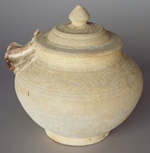| Discovering Asia's
ceramic development |
Firing temperature
 These
celadon jarlets are all from the Royal Nanhai. They have been immersed
in salt water for the same length of time, in the same environment, but show
very different 'survival' grades. This is probably due to different firing temperatures.
If the iron oxide in the glaze matrix is not fully dissolved by a sufficiently
high firing temperature, it will crystallize on the surface. Once in contact
with salt water it will corrode, pit the surface, and then slowly damage the
entire surface. The jar on the left was well-fired. The two right-hand examples
have both deteriorated, except in one patch which was protected by seashells.
These
celadon jarlets are all from the Royal Nanhai. They have been immersed
in salt water for the same length of time, in the same environment, but show
very different 'survival' grades. This is probably due to different firing temperatures.
If the iron oxide in the glaze matrix is not fully dissolved by a sufficiently
high firing temperature, it will crystallize on the surface. Once in contact
with salt water it will corrode, pit the surface, and then slowly damage the
entire surface. The jar on the left was well-fired. The two right-hand examples
have both deteriorated, except in one patch which was protected by seashells.
Reduction
atmosphere
 To
achieve a green celadon glaze from the original whitish clay matrix, the kiln
atmosphere has to be reduced, by shutting off oxygen at a precise moment in
the firing cycle. These jarlets are also from the Royal Nanhai. One was
subject to the correct reduction atmosphere and turned celadon-green. The other
was incorrectly fired, with inadequate or late reduction, and maintained its
original clay colour.
To
achieve a green celadon glaze from the original whitish clay matrix, the kiln
atmosphere has to be reduced, by shutting off oxygen at a precise moment in
the firing cycle. These jarlets are also from the Royal Nanhai. One was
subject to the correct reduction atmosphere and turned celadon-green. The other
was incorrectly fired, with inadequate or late reduction, and maintained its
original clay colour.
 Glaze
fastenings
Glaze
fastenings
Ceramics with lids were often joined with small glaze droplets during manufacturing.
This prevented misplacement during packing and transport. Tapping the joint
with a sharp object easily separates body and lid. This jar from the Royal
Nanhai remains unopened, after five centuries.
 These
celadon jarlets are all from the Royal Nanhai. They have been immersed
in salt water for the same length of time, in the same environment, but show
very different 'survival' grades. This is probably due to different firing temperatures.
If the iron oxide in the glaze matrix is not fully dissolved by a sufficiently
high firing temperature, it will crystallize on the surface. Once in contact
with salt water it will corrode, pit the surface, and then slowly damage the
entire surface. The jar on the left was well-fired. The two right-hand examples
have both deteriorated, except in one patch which was protected by seashells.
These
celadon jarlets are all from the Royal Nanhai. They have been immersed
in salt water for the same length of time, in the same environment, but show
very different 'survival' grades. This is probably due to different firing temperatures.
If the iron oxide in the glaze matrix is not fully dissolved by a sufficiently
high firing temperature, it will crystallize on the surface. Once in contact
with salt water it will corrode, pit the surface, and then slowly damage the
entire surface. The jar on the left was well-fired. The two right-hand examples
have both deteriorated, except in one patch which was protected by seashells.
 Glaze
fastenings
Glaze
fastenings